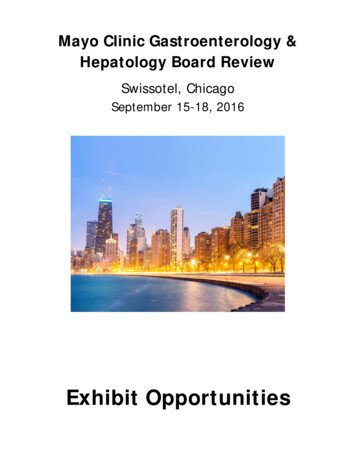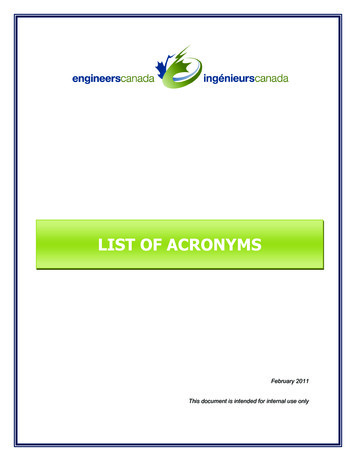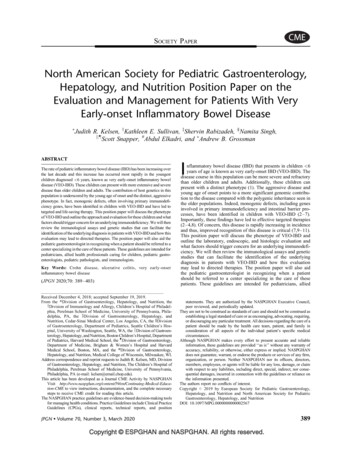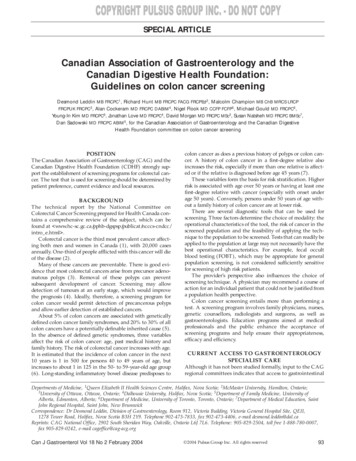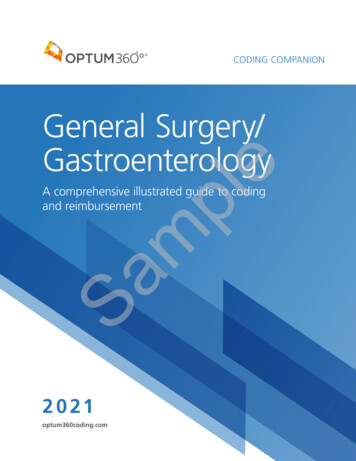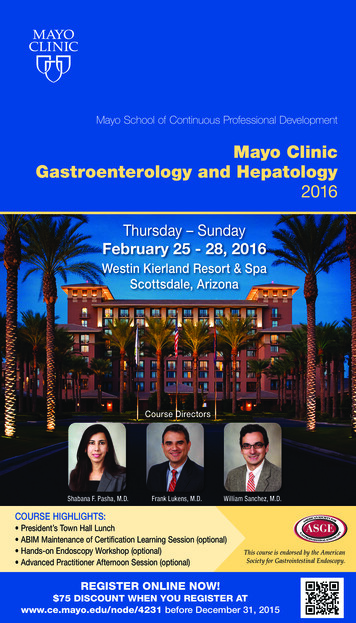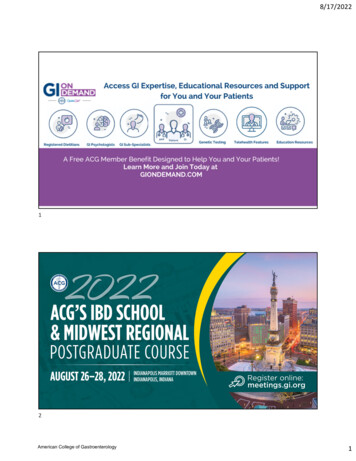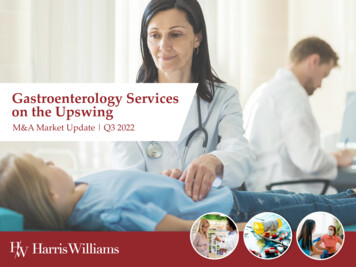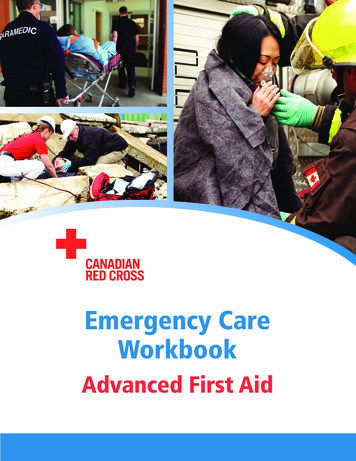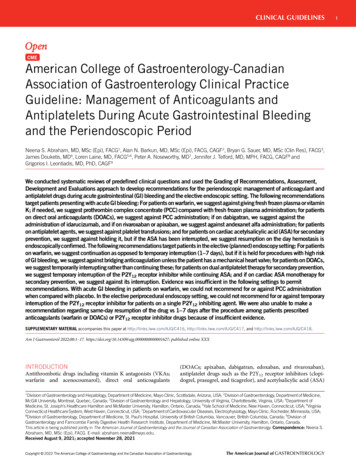
Transcription
CLINICAL GUIDELINESAmerican College of Gastroenterology-CanadianAssociation of Gastroenterology Clinical PracticeGuideline: Management of Anticoagulants andAntiplatelets During Acute Gastrointestinal Bleedingand the Periendoscopic PeriodNeena S. Abraham, MD, MSc (Epi), FACG1, Alan N. Barkun, MD, MSc (Epi), FACG, CAGF2, Bryan G. Sauer, MD, MSc (Clin Res), FACG3,James Douketis, MD4, Loren Laine, MD, FACG5,6, Peter A. Noseworthy, MD7, Jennifer J. Telford, MD, MPH, FACG, CAGF8 andGrigorios I. Leontiadis, MD, PhD, CAGF9We conducted systematic reviews of predefined clinical questions and used the Grading of Recommendations, Assessment,Development and Evaluations approach to develop recommendations for the periendoscopic management of anticoagulant andantiplatelet drugs during acute gastrointestinal (GI) bleeding and the elective endoscopic setting. The following recommendationstarget patients presenting with acute GI bleeding: For patients on warfarin, we suggest against giving fresh frozen plasma or vitaminK; if needed, we suggest prothrombin complex concentrate (PCC) compared with fresh frozen plasma administration; for patientson direct oral anticoagulants (DOACs), we suggest against PCC administration; if on dabigatran, we suggest against theadministration of idarucizumab, and if on rivaroxaban or apixaban, we suggest against andexanet alfa administration; for patientson antiplatelet agents, we suggest against platelet transfusions; and for patients on cardiac acetylsalicylic acid (ASA) for secondaryprevention, we suggest against holding it, but if the ASA has been interrupted, we suggest resumption on the day hemostasis isendoscopically confirmed. The following recommendations target patients in the elective (planned) endoscopy setting: For patientson warfarin, we suggest continuation as opposed to temporary interruption (1–7 days), but if it is held for procedures with high riskof GI bleeding, we suggest against bridging anticoagulation unless the patient has a mechanical heart valve; for patients on DOACs,we suggest temporarily interrupting rather than continuing these; for patients on dual antiplatelet therapy for secondary prevention,we suggest temporary interruption of the P2Y12 receptor inhibitor while continuing ASA; and if on cardiac ASA monotherapy forsecondary prevention, we suggest against its interruption. Evidence was insufficient in the following settings to permitrecommendations. With acute GI bleeding in patients on warfarin, we could not recommend for or against PCC administrationwhen compared with placebo. In the elective periprocedural endoscopy setting, we could not recommend for or against temporaryinterruption of the P2Y12 receptor inhibitor for patients on a single P2Y12 inhibiting agent. We were also unable to make arecommendation regarding same-day resumption of the drug vs 1–7 days after the procedure among patients prescribedanticoagulants (warfarin or DOACs) or P2Y12 receptor inhibitor drugs because of insufficient evidence.SUPPLEMENTARY MATERIAL accompanies this paper at http://links.lww.com/AJG/C416, http://links.lww.com/AJG/C417, and http://links.lww.com/AJG/C418.Am J Gastroenterol 2022;00:1–17. https://doi.org/10.14309/ajg.0000000000001627; published online XXXINTRODUCTIONAntithrombotic drugs including vitamin K antagonists (VKAs;warfarin and acenocoumarol), direct oral anticoagulants(DOACs; apixaban, dabigatran, edoxaban, and rivaroxaban),antiplatelet drugs such as the P2Y12 receptor inhibitors (clopidogrel, prasugrel, and ticagrelor), and acetylsalicylic acid (ASA)1Division of Gastroenterology and Hepatology, Department of Medicine, Mayo Clinic, Scottsdale, Arizona, USA; 2Division of Gastroenterology, Department of Medicine,McGill University, Montreal, Quebec, Canada; 3Division of Gastroenterology and Hepatology, University of Virginia, Charlottesville, Virginia, USA; 4Department ofMedicine, St. Joseph’s Healthcare Hamilton and McMaster University, Hamilton, Ontario, Canada; 5Yale School of Medicine, New Haven, Connecticut, USA; 6VirginiaConnecticut Healthcare System, West Haven, Connecticut, USA; 7Department of Cardiovascular Diseases, Electrophysiology, Mayo Clinic, Rochester, Minnesota, USA;8Division of Gastroenterology, Department of Medicine, St. Paul’s Hospital, University of British Columbia, Vancouver, British Columbia, Canada; 9Division ofGastroenterology and Farncombe Family Digestive Health Research Institute, Department of Medicine, McMaster University, Hamilton, Ontario, Canada.This article is being published jointly in The American Journal of Gastroenterology and the Journal of Canadian Association of Gastroenterolgy. Correspondence: Neena S.Abraham, MD, MSc (Epi), FACG. E-mail: abraham.neena@mayo.edu.Received August 9, 2021; accepted November 28, 2021Copyright 2022 The American College of Gastroenterology and the Canadian Association of Gastroenterology.The American Journal of GASTROENTEROLOGY1
2Abraham et al.are used in the management of patients with atrial fibrillation,ischemic heart disease, venous thromboembolism, and valvularheart disease. These drugs also increase the risk of gastrointestinal(GI) bleeding from luminal sources such as ulcers or diverticulaand after endoscopic procedures (1–3). Standardized, evidencebased protocols are lacking to inform best practices before andafter endoscopic procedures in urgent and elective settings.Furthermore, uncertainty regarding best practice recommendations and associated levels of evidence has led to significant variation in adherence to guideline-directed practices (4).The American College of Gastroenterology (ACG) and theCanadian Association of Gastroenterology (CAG) convened aninternational, multisociety, and multidisciplinary working groupto create a focused, pragmatic guideline after distillation of published literature to inform clinical practice in the periendoscopicperiod. In keeping with the Grading of Recommendations, Assessment, Development and Evaluations (GRADE) approach (5),the most pertinent clinical questions guided the systematic reviewof the literature, with the resulting rigorous methodological evaluation of the available published data informing recommendations. In this document, we propose an evidence-based approach toperiprocedural antithrombotic drug management in commonemergent and elective settings addressing clinical questions relatedto (i) temporary interruption of anticoagulant and antiplateletdrugs; (ii) reversal of anticoagulant and antiplatelet drugs; (iii)periprocedural heparin bridging; and (iv) postprocedural resumption of anticoagulant and antiplatelet drugs.This document does not cover all possible clinical situationswhere multidisciplinary guidance may be necessary to manageperiendoscopic antithrombotic therapy. Nor does it address therapidly evolving menu of endoscopic approaches developed tominimize intraprocedural and postprocedural bleeding in situations such as removing large colonic polyps (6). Because of insufficient evidence, the panel could not recommend a bestpractice for all clinical questions. These clinical situations areidentified as priorities for future research.METHODSThese guidelines are established to support clinical practice andsuggest preferable approaches to a typical patient with a particularmedical problem based on the currently available published literature. When exercising clinical judgment, particularly whentreatments pose significant risks, healthcare providers shouldincorporate this guideline in addition to patient-specific medicalcomorbidities, health status, and preferences to arrive at a patientcentered care approach.The methods for this guideline were agreed on a priori by theACG and the CAG with the express intent to codevelop highquality multisociety guidelines that reduce duplication of effortand improve impact. The methods have followed the GRADEapproach (5). The target population of this guideline is patientsreceiving anticoagulants or antiplatelet drugs who are (i) hospitalized or under observation with acute GI bleeding or (ii) undergoing inpatient or outpatient elective GI endoscopicprocedures. The target audience for this guideline includeshealthcare providers, public health policymakers, patients, andcaregivers.The guideline panel was led by 2 gastroenterology cochairs(N.S.A. and A.N.B.). It included 6 voting content experts—4gastroenterologists (N.S.A., A.N.B., L.L., and J.T.), 1 cardiologist (P.A.N.), 1 thrombosis expert (J.D.), and 2 nonvotingThe American Journal of GASTROENTEROLOGYgastroenterologists who served as the GRADE methodologists(G.I.L. and B.S.). No patients were included in the guidelineprocess. The panel developed, prioritized, and finalized theclinical questions in Population, Intervention, Comparator, andOutcome (PICO) format through teleconferences before systematic literature reviews. The critical outcomes were 7-dayfurther bleeding and 30-day thrombotic events for patients withacute GI bleeding and 30-day bleeding and 30-day thromboticevents after elective endoscopic procedures. The final PICOquestions were shared with the leadership of the ACG PracticeParameters Committee and the CAG Clinical Affairs Committee.The editorial office of the Cochrane Gut Group at McMasterUniversity developed and ran searches in MEDLINE, EMBASE,and CENTRAL for randomized controlled trials (RCTs), controlled or uncontrolled observational studies, and systematic reviews of any study design published in the English language as fulltext (conference abstracts were not included) between January 1,1995 (January 1, 1985, for some searches), and August 13, 2020.Full details of search strategies can be found in SupplementaryDigital Content (see Appendix 1, http://links.lww.com/AJG/C416). Each identified abstract was screened for eligibility induplicate by at least 2 of the 4 voting gastroenterologists. Potentially eligible studies were assessed as full-text articles by theGRADE methodologists or 1 of the 4 voting gastroenterologists.A GRADE methodologist verified data extraction. An evidencemap was prepared for each PICO question. The panel reviewedthe preliminary evidence map, proposed additional articles, andassisted in supplementary literature searches targeting broaderpopulations when gaps in the evidence were identified. Whereappropriate, more recent publications available after the formalliterature search and evidentiary review are discussed for contextual information if deemed to provide critical additionalcontemporary insight.The 2 GRADE methodologists prepared assessments of therisk of bias of each included study and developed complete evidence reports, including a summary of evidence tables (see Appendix 2, Supplementary Digital Content, http://links.lww.com/AJG/C417). The certainty of the evidence for each PICO questionwas categorized as very low, low, moderate, or high depending onthe assessment of (i) limitations in the design and execution of thestudies, (ii) indirectness, (iii) inconsistency, (iv) imprecision, and(v) other considerations including publication bias, according tothe GRADE approach (7,8). Manuscripts initially deemed potentially eligible but eventually excluded are listed in Supplementary Digital Content (see Appendix 3, http://links.lww.com/AJG/C418) with reasons for exclusion. Each GRADE methodologist, in turn, prepared half of the evidence reports, whereas theother methodologist double-checked them, providing feedbackuntil agreement was achieved. For each PICO, 3 versions of thewording of the potential recommendation were prepared a priori(in favor, against, or unable to recommend). The opinions ofindividual content experts were sought for specific issues. Theevidence reports and risk of bias tables were shared with the wholepanel on April 16, 2021, and discussed by email. The finalizeddocument was shared before the voting videoconference meetings on May 8 and 15, 2021.One cochair (A.N.B.) and 1 GRADE methodologist (G.I.L.)moderated the voting videoconference meetings. For each PICO,the GRADE methodologist presented a summary of the evidence,including the direction and magnitude of effect for desirable andundesirable outcomes and the certainty of the evidence. AfterVOLUME 00 MONTH 2022 www.amjgastro.com
ACG-CAG Clinical Practice GuidelineTable 1. Guideline statements, the strength of recommendation,and certainty of the evidence for the management ofantithrombotic agents in the setting of acute GI bleedTable 2. Guideline statements, the strength of recommendation,and certainty of the evidence for the management ofantithrombotic agents in the elective endoscopy settingManagement of antithrombotic agents in the setting of acute GI bleedManagement of antithrombotic agents in the elective endoscopy settingVitamin K antagonist reversalAnticoagulant interruption vs continuation1. For patients on warfarin who are hospitalized or under observation withacute GI bleeding, we suggest against FFP administration (conditionalrecommendation, very low certainty of evidence).2. For patients on warfarin who are hospitalized or under observation withacute GIB, we could not reach a recommendation for or against PCCadministration.3. For patients on warfarin who are hospitalized or under observation withacute GIB, we suggest PCC administration compared with FFPadministration (conditional recommendation, very low certainty ofevidence).4. For patients on warfarin who are hospitalized or under observation withacute GIB (upper and/or lower), we suggest against the use of vitamin K(conditional recommendation, very low certainty of evidence).Direct thrombin inhibitor reversal (dabigatran)5. For patients on dabigatran who are hospitalized or under observationwith acute GIB, we suggest against the administration of idarucizumab(conditional recommendation, very low certainty of evidence).Reversal of rivaroxaban/apixaban with andexanet alfa6. For patients on rivaroxaban or apixaban who are hospitalized or underobservation with acute GIB, we suggest against andexanet alfa administration(conditional recommendation, very low certainty of evidence).Reversal of direct oral anticoagulant with PCC7. For patients on DOACs who are hospitalized or under observation withacute GIB, we suggest against PCC administration (conditionalrecommendation, very low certainty of evidence).Reversal of antiplatelet with platelet transfusion8. For patients on antiplatelet agents who are hospitalized or underobservation with acute GIB, we suggest against platelet transfusions(conditional recommendation, very low certainty of evidence).Holding ASA vs continuing ASA9. For patients with GI bleeding on cardiac ASA for secondary prevention, wesuggest against holding the ASA (conditional recommendation, very lowcertainty of evidence).Resumption of ASA after endoscopic hemostasis10. For patients with GI bleeding on ASA for secondary cardiovascularprevention whose ASA was held, we suggest the ASA be resumed on theday hemostasis is endoscopically confirmed (conditionalrecommendation, very low certainty of evidence).ASA, acetylsalicylic acid; FFP, fresh frozen plasma; DOAC, direct oral anticoagulant;GI, gastrointestinal; GIB, GI bleeding; PCC, prothrombin complex concentrate.which, the panel discussed results. All domains of the Evidenceto-Decision Framework (9), including the certainty of evidenceon the balance between desirable and undesirable outcomes, evidence and assumptions about patient values and preferences,feasibility, acceptability, and resource use associated with alternative management options, were reviewed, agreed on, summarized, and tabulated in real time for the PICO question beingassessed (7,9). Notes were taken with regards to qualifiers and11. For patients on warfarin undergoing elective/planned endoscopic GIprocedures, we suggest warfarin be continued, as opposed to temporarilyinterrupted (1–7 d) (conditional recommendation, very low certainty ofevidence).12. For patients on warfarin, who hold warfarin in the periproceduralperiod for elective/planned endoscopic GI procedures, we suggest againstbridging anticoagulation (conditional recommendation, low certainty ofevidence).13. For patients on DOACs who are undergoing elective/plannedendoscopic GI procedures, we suggest temporarily interrupting DOACsrather than continuing DOACs (conditional recommendation, very lowcertainty of evidence).Antiplatelet interruption vs continuation14a. For patients on dual antiplatelet therapy for secondary preventionwho are undergoing elective endoscopic GI procedures, we suggesttemporary interruption of the P2Y12 receptor inhibitor while continuingASA (conditional recommendation, very low certainty of evidence).14b. For patients on single antiplatelet therapy with a P2Y12 receptorinhibitor who are undergoing elective endoscopic GI procedures, wecould not reach a recommendation for or against temporary interruption ofthe P2Y12 receptor inhibitor.15. For patients on ASA 81–325 mg/d (i.e., cardiac ASA monotherapy) forsecondary prevention, we suggest against interruption of ASA (conditionalrecommendation, very low certainty of evidence).Timing of anticoagulant resumption after endoscopy16. In patients who are undergoing elective endoscopic GI procedureswhose warfarin was interrupted, we could not reach a recommendation foror against resuming warfarin the same day vs 1–7 d after the procedure.17. In patients who are undergoing elective endoscopic GI procedures whoseDOAC was interrupted, we could not reach a recommendation for or againstresuming the DOAC on the same day of the procedure vs 1–7 d after theprocedure.Timing of P2Y12 inhibitor resumption after endoscopy18. In patients who are undergoing elective endoscopic GI procedureswhose P2Y12 inhibitor was interrupted, we could not reach arecommendation for or against resuming P2Y12 inhibitor on the same dayof the procedure vs 1–7 d after the procedure.ASA, acetylsalicylic acid; DOAC, direct oral anticoagulant; GI, gastrointestinal.dissenting opinions. The 6 voting panel members then voted onthe direction of the recommendation (in favor vs against) for thatPICO question with its corresponding wording. The predetermined threshold vote for consensus was 75% (i.e., 5 of 6panel members). If consensus was not reached, the topic wasfurther discussed, and reasons for disagreement were sought, withthe panel voting for a second time. If the 75% threshold could stillnot be reached, the conclusion that “we could not reach a recommendation for or against” the intervention was assigned tothat PICO question.Copyright 2022 The American College of Gastroenterology and the Canadian Association of Gastroenterology.The American Journal of GASTROENTEROLOGY3
4Abraham et al.If the 75% threshold was reached, provided the certainty of theevidence was moderate or high, panel members intended to discussand vote on the strength of recommendation (strong vs conditional). If 75% of the members voted for strong, the recommendation would begin with “we recommend that .” Strongrecommendations imply that most informed patients wouldchoose the recommended course of action, and clinicians shouldprovide it to most patients (7). If less than 75% of the membersvoted for strong, the recommendation would be considered conditional and began with the words “we suggest that .” Conditionalrecommendations indicate that most individuals in this situationwould want the suggested course of action. Still, others would not,and clinicians should help each patient make decisions consistentwith their risks, values, and preferences, ideally using decision aids.Recommendations with low or very low certainty of evidence weredesignated as conditional by default (without voting on thestrength), although such recommendations could have still beenconsidered as strong if they had fulfilled criteria for 1 of the 4“paradigmatic situations” (10). A search of contemporary studiesand recent systematic reviews was also performed and detailed inthe evidence profile to inform the panel deliberations concerningthe preferences of providers and patients for a cardiovascular eventvs a GI bleeding event (see Appendix 2, Supplementary DigitalContent, http://links.lww.com/AJG/C417 pages 3–6).Each voting panel member, including the 2 cochairs, prepareda draft for designated sections after the voting videoconferencemeeting. The 2 cochairs subsequently edited and merged theseinto a single manuscript. The final version was reviewed andapproved unanimously. The final manuscript was peer-reviewedby the ACG Practice Parameters Committee, CAG Clinical Affairs Committee, the ACG Board of Trustees, the CAG chair ofClinical Practice, the CAG vice president for Clinical Affairs, theCAG Board of Directors, and the CAG membership at large (towhom the document was made available for 2 weeks). For eachPICO question, the evidence table that summarizes the data andthe grading of that evidence is in Supplementary Digital Content(see Appendix 2, http://links.lww.com/AJG/C417). A completelist of guideline statements, the strength of recommendation, andthe certainty of the evidence is found in Tables 1 and 2.GUIDELINE STATEMENTSSummary of evidence. For this recommendation, no eligiblestudies specifically addressing patients with GI bleeding wereidentified by literature searches. The observational studiesidentified were cohort studies without a comparator arm, orthe study did not report separate results for clinical outcomesin patients with GI bleeding. It is thus not possible to infer withany certainty whether administering FFP can benefit, harm, ormake no difference in these patients compared with noreversal.Pertinent studies included a small cohort of 41 warfarintreated patients requiring rapid reversal (12), with 12 receivingFFP, 29 receiving clotting factor concentrates, and all receivingvitamin K 1–5 mg intravenously. No clinical outcomes weremeasured, but in the 12 patients given FFP, the internationalnormalized ratio (INR) did not normalize (range 1.6–3.8,mean 2.3), indicating an ongoing anticoagulated state in allpatients. In a case-control study of 267 patients with majorbleeding prescribed VKA for venous thromboembolism, 78patients had GI bleeding, but no results were reported for theGI bleeding outcomes (13). In a multivariable analysis thatfailed to adjust sufficiently for confounding, FFP use was associated with a higher risk of thrombotic events (OR: 4.22; 95%CI: 1.25–14.3) (13).Three additional RCTs which lacked the comparator of interest (i.e., placebo) provide cohort-type data that further inform this recommendation. Sarode et al. randomized 202patients on a VKA with an INR 2.0 and major bleeding to FFP(n 5 104) vs 4-factor prothrombin complex concentrate (PCC),while both arms received vitamin K (5–10 mg intravenously). Inthe FFP arm, 58 patients had GI bleeding with excellent or goodhemostatic efficacy achieved in 75.9% (14). Additional outcomemeasures were reported only for all-cause bleeding and includedthrombotic events in 7 of 109, mortality in 6 of 103, rapid INRreduction in 10 of 109, and fluid overload after 10–45 days in 14of 109. Smaller RCTs by Steiner et al. (15) (N 5 50, 23 in the FFParm) and Boulis et al. (16) (N 5 13, 8 in the FFP arm) assessedpatients with intracranial hemorrhage, reporting thromboembolic events in 2 of 23 and 1 of 8 patients, respectively, and anINR #2 within 3 hours of treatment in 2 of 23 patients; significant complications from fluid overload were noted in 5 of 8patients.VKA reversal.Conclusions. Although there is biological plausibility of FFPadministration to reverse VKA in patients with GI bleeding, thereexists only very low certainty evidence, given serious concerns ofrisk of bias, imprecision, and indirectness. The panel also considered the low cost of FFP, relevant patient utilities, and thepotential increased risk of transmission of infectious agents withFFP administration. The panel suggested that FFP should not beused routinely but could be considered for patients with a lifethreatening GI bleed or a supratherapeutic INR substantiallyexceeding the therapeutic range. Its use could also be consideredin those for whom massive blood transfusion is undesirablebecause of its effect on coagulopathy or dilution of bloodcomponents when PCC is unavailable (see below).1. For patients on warfarin who are hospitalized or under observationwith acute GI bleeding, we suggest against fresh frozen plasma (FFP)administration (conditional recommendation, very low certainty ofevidence).2. For patients on warfarin who are hospitalized or under observationwith acute GI bleeding, we could not reach a recommendation for oragainst prothrombin complex concentrate administration.Management of antithrombotic agents in the setting of acuteGI bleedingThe first 10 guideline statements address the management of antithrombotic agents in the setting of acute GI bleeding. Acute GI bleeding isdefined as patients hospitalized or under observation with acute overtGI bleeding (upper and/or lower) manifesting as melena, hematochezia, or hematemesis. Life-threatening hemorrhage is defined asmajor clinically overt or apparent bleeding, resulting in hypovolemicshock or severe hypotension requiring pressors or surgery; or associated with a decrease in hemoglobin of .5 g/dL, or requiring transfusion of 5 units of packed red blood cells, or causing death (11).The American Journal of GASTROENTEROLOGYVOLUME 00 MONTH 2022 www.amjgastro.com
ACG-CAG Clinical Practice GuidelineSummary of evidence. The panel made an a priori decision toconsider 3-factor PCC and 4-factor PCC equivalent for theintervention (PCC for reversal of warfarin and other VKAs). Noeligible studies were identified exclusively in patients with GIbleeding. A backward (snowballing) citation search of previousguidelines was used to identify supporting evidence, includingnoncomparative cohort data derived from the PCC arms of 2RCTs that compared PCC vs FFP (14,15). We also considered acohort study of GI patients, which provided clinical outcomes andresults on the indirect outcome of INR reversal (17). This studywas regarded as noncomparative data with the inclusion of thePCC group only.From 7 studies, there were 223 patients on warfarin, all experiencing major bleeding and treated with PCC (14,15,17–21).Of these, 38.6% had GI bleeding. All patients received 4-factorPCC at various doses, with vitamin K administered to most patients. Further bleeding was observed in 25.5%, with a 7.2% incidence of thrombotic events and 30-day mortality of 7.0%(14,15,17–21). One study estimated transfusion-related events(fluid overload) of 4.9% within 7 days of PCC use (14). All studiesdemonstrated consistently rapid INR reduction of a large magnitude. Given the pharmacodynamics of warfarin treatment, itwas implausible that this dramatic INR change could have occurred because of bias, confounding, or chance.Studies were downrated for serious or very serious risk of bias(no comparator cohorts), indirectness of the outcome (“hemostatic efficacy” or active bleeding visualized at the time of endoscopy), and the concomitant use of vitamin K. The smallnumber of events contributed to serious imprecision. Only asmall proportion of the patients had GI bleeds, although the typeof bleed would not have influenced the effect of PCC on the INR.Finally, the speed of INR correction is a surrogate outcome, not aclinical outcome.0.55–2.00). However, the study’s definition of successful hemostasis allowed for up to 2 additional units of blood products afterreceiving FFP or PCC. It did not report whether this cointervention differed between the 2 groups. Furthermore, a higherproportion of patients in the FFP arm received vitamin K, including intravenously.A prospective cohort study of patients with acute upper GIbleeding who received intravenous vitamin K and either FFP orPCC found that the absolute risk of further bleeding was numerically lower in the PCC arm with zero of 20 patients diagnosed with bleeding compared with 7 of 20 patients (35%) inthe FFP arm but without statistical significance (RR 0.07, 95%CI: 0–1.09) (17). An additional 3 patients in the FFP arm developed recurrent bleeding, but it was unclear whether these 3patients were independent of the 7 patients already attributed.Regardless, their inclusion would not change the direction of theeffect nor certainty of evidence.The risk of thromboembolic events in patients on warfarin randomized to receive either FFP or PCC was evaluated in 2 studies. In 1study, the bleeding site was intracranial, whereas in the second study,the bleeding site varied and included GI bleeding in some patients(14,15). Combining results from both studies, although not significant, the absolute risk of thromboembolic events was numericallyhigher in the PCC arm (RR 5 1.60, 95% CI: 0.70–3.62), whereas the30-day mortality (RR 5 0.64, 95% CI: 0.17–2.49) and transfusionrelated adverse events (1 transfusion-related anaphylaxis in the FFPgroup) (14) were numerically lower in the PCC arm. Both studiesdemonstrated a more rapid INR reduction in patients receiving PCCthan FFP (RR 5 6.99, 95% CI: 3.61–13.53). The heterogeneous studypopulations, variability in outcome definition and timing of assessment, and the wide confidence intervals for clinical outcomes led to avery low certainty of evidence.Conclusions. The effect of PCC compared with FFP on furtherConclusions. There is insufficient evidence to judge the balancebetween desirable and undesirable effects with PCC administration; thus, the panel was unable to issue a recommendation.The guideline panel implicitly considered evidence from thecomparison of PCC with FFP for warfarin reversal that didreveal a favorable profile for PCC use and benefit in studiesusing the surrogate endpoint of INR correction. PCC is notnecessary for most patients on warfarin with a GI bleed. PCCadministration could be considered in patients with a lifethreatening GI bleed, those with a supratherapeutic INRsubstantially exceeding the therapeutic range, or in patientsin whom mas
Canadian Association of Gastroenterology (CAG) convened an international, multisociety, and multidisciplinary working group to create a focused, pragmatic guideline after distillation of pub-lished literature to inform clinical practice in the periendoscopic period. In keeping with the Grading of Recommendations, As-
